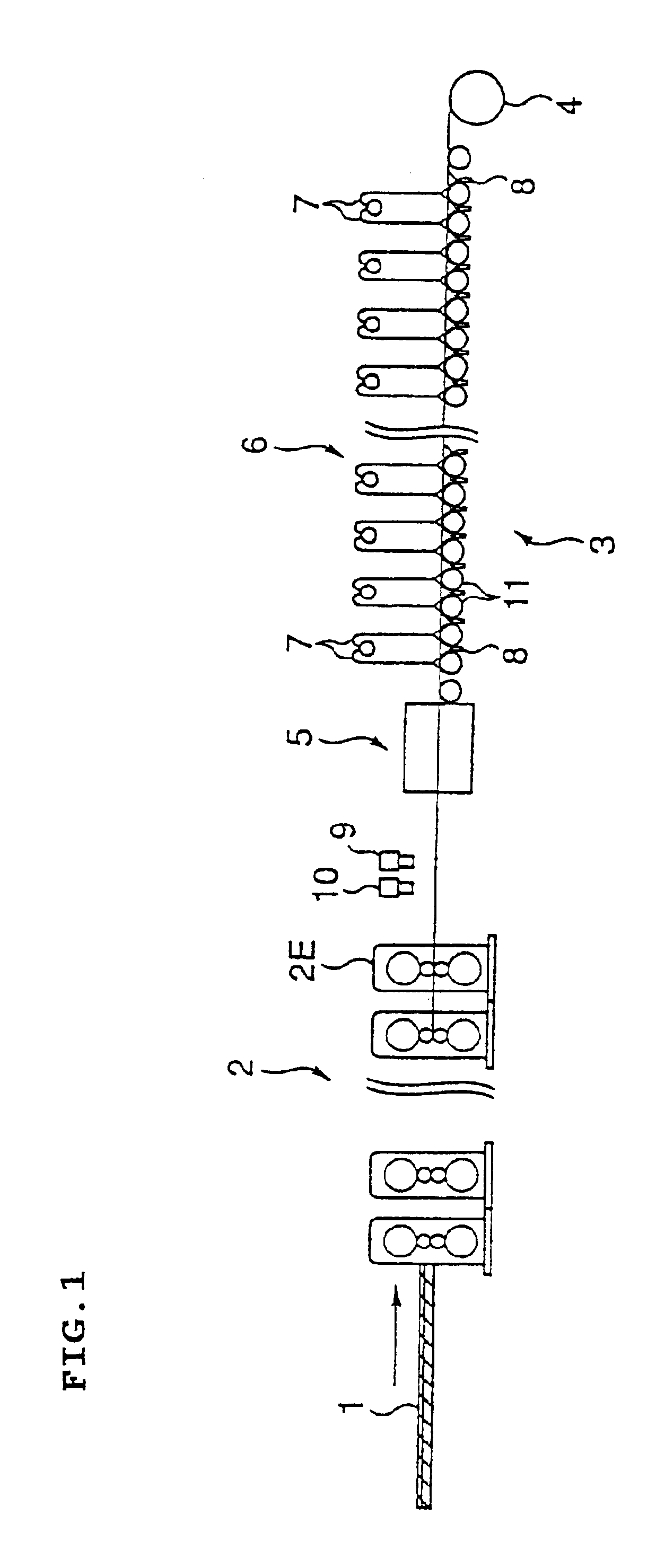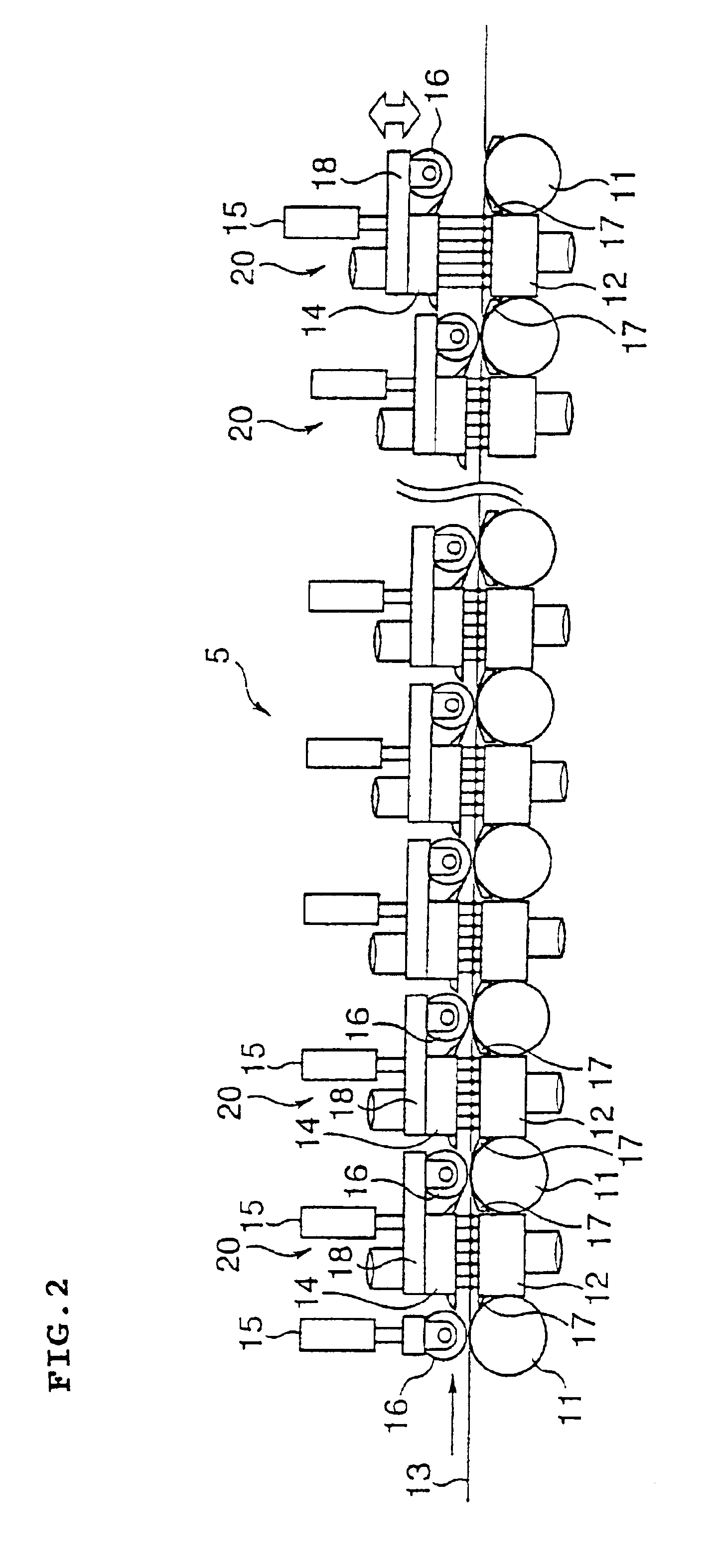Method and apparatus for cooling hot rolled steel strip, and method for manufacturing hot rolled steel strip
a hot rolled steel and cooling technology, applied in the direction of heat treatment equipment, manufacturing tools, furnaces, etc., can solve the problems of rapid cooling, intermittent cooling, and inability to achieve a cooling speed of 200.degree. c/sec or more for 3 mm sheet thickness
- Summary
- Abstract
- Description
- Claims
- Application Information
AI Technical Summary
Benefits of technology
Problems solved by technology
Method used
Image
Examples
first embodiment
FIG. 1 shows schematically a manufacturing equipment of a hot rolled steel strip of the first embodiment and FIG. 2 indicates schematically a first cooling apparatus.
A rough bar 1 rolled by a roughing mill is transferred on transfer rolls of a transfer means and is guided to a runout table 3 behind a final finishing mill 2E after rolling sequentially to the specified thickness by seven stands of continuous finishing mill 2. Most areas of the runout table 3 are equipped with a cooling apparatus (cooling means) where a steel strip is cooled and rolled up by a coiler to form a hot rolled coil.
The narrower a mutual distance between transfer rolls 11 comprising the runout table the more stable a plate passage ability is, but if too narrowed no space is available to arrange the cooling apparatus to extend a cooling length to deteriorate a cooling efficiency. Therefore, the mutual distance between the transfer rolls 11 is desirable to be from a roll diameter plus 100 mm to about three time...
second embodiment
FIG. 3 shows a schematic drawing of a manufacturing equipment of a hot rolled steel strip at the
A rough bar 1 rolled at a roughing mill is transferred on the transfer rolls to roll to the specified thickness by passing seven units of continuous finishing mill 2 and finally is guided to a runout table 3 behind the final finishing mill 2E. The runout table is 80 m in an entire length typically comprising a cooling apparatus at which the plate is cooled and rolled up by a coiler 4 to form the hot rolled coil.
A cooling apparatus (cooling means) 25 provided at the runout table 3 comprises plural circular laminar nozzles 26 arranged at the specified pitch at the upper surface of the runout table 3 and plural spray nozzles 27 provided between the transfer rolls 11 comprising the transfer means of the steel strip at the lower side. A water breaking device (water breaking means) described later is arranged at the outlet of the cooling apparatus 25.
A water breaking device 28 above and its per...
third embodiment
FIG. 5 shows a schematic drawing of a manufacturing equipment of a hot rolled steel strip at the A rough bar 1 rolled at a roughing mill is transferred on transfer rolls to roll to the specified thickness by passing seven units of continuous finishing mill 2 and finally is guided to a runout table 3 installed extending to 80 m behind a final finishing mill 2E. Most of the runout table comprises a cooling apparatus cools at which the steel strip 13 is cooled and rewound by the coiler 4 to form the hot rolled coil.
The runout table 3 is equipped with a proximity cooling apparatus 34 described later of about 15 m in length and after with a water breaking device 28A described later is provided.
The cooling apparatus 34 above comprises as shown in FIG. 6. The drawing shows the rotating transfer rolls 11 of 350 mm in diameter are arranged at about 800 mm pitch in the longitudinal direction at the lower side. Between the transfer rolls 11, the lower cooling nozzles 35 are provided for about...
PUM
| Property | Measurement | Unit |
|---|---|---|
| distance | aaaaa | aaaaa |
| thickness | aaaaa | aaaaa |
| thickness | aaaaa | aaaaa |
Abstract
Description
Claims
Application Information
 Login to View More
Login to View More - R&D
- Intellectual Property
- Life Sciences
- Materials
- Tech Scout
- Unparalleled Data Quality
- Higher Quality Content
- 60% Fewer Hallucinations
Browse by: Latest US Patents, China's latest patents, Technical Efficacy Thesaurus, Application Domain, Technology Topic, Popular Technical Reports.
© 2025 PatSnap. All rights reserved.Legal|Privacy policy|Modern Slavery Act Transparency Statement|Sitemap|About US| Contact US: help@patsnap.com



